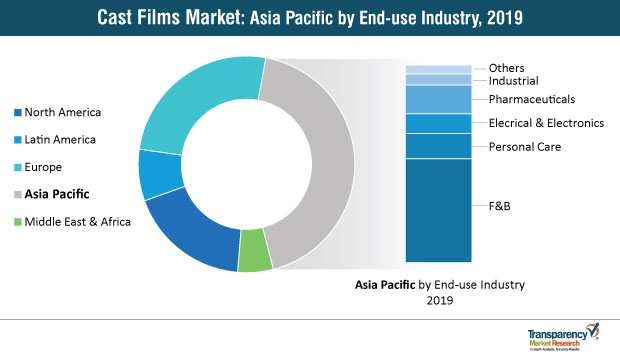
The packaging industry is becoming an integral part of a wide range of end-use industries. The increasing demand for see-through packaging solutions is triggering the demand for high-performance barrier materials, such as cast films. The demand for high-quality cast films is increasing, as the packaging industry is regulated by various governing bodies as well as environmental organizations, which has amplified the importance of optical properties and quality of the raw materials of cast films.
The cast films landscape is expanding into new industrial verticals, as market players are foraying into versatile areas of applications to improve the sales potential of cast films. Pharmaceuticals and personal care industries are emerging as top new application areas for cast films market players, and this is triggering innovation in the landscape, as manufacturers are focusing on meeting the specific requirements of end users in these industries.
Right from innovation in engineered plastic, which is the primary raw material in cast films, to unique features of cast film-based packaging solutions, such as anti-counterfeiting cast film labels for pharmaceuticals, the cast films landscape is attracting investors. Transparency Market Research (TMR) thoroughly studies the market, in its latest offering, and offers exclusive and actionable insights for market players to gain an edge in this landscape.

Planning to lay down future strategy? Perfect your plan with our report brochure here
Cast Films Market: Innovation Centered around Raw Materials
The cast films market grew at a healthy CAGR (Compound Annual Growth Rate) during 2014-2018, reaching a valuation of ~ US$ 60.2 billion in 2018. With their performance benefits over blown films, the demand for cast films is expected to prevail in the coming years. Market players are now competing on the distinguished performance characteristics of cast films by adopting high-performance raw materials.
TMR’s study finds that, polypropylene is the most widely used raw material in the cast films landscape, owing to its superior performance characteristics over other plastics used in cast films. Many market players are also experimenting by using innovative raw materials by combining two different materials to further boost the performance characteristics of cast films.
In addition, sustainability is becoming an important aspect for manufacturers in the cast films landscape, as end users are willing to reduce the carbon footprint of their businesses, and consumers are becoming more aware about the recyclability of plastic-based packaging materials. However, owing to the complexity of packaging formats of cast film-derived packaging solutions, recycling multilayer cast film packaging on a commercial scale is becoming a critical challenge for stakeholders in the cast films market.
Rising Demand for Cast Films in Multilayer Pouches to Define Future Market Trends
The global market for flexible packaging solutions is expanding rapidly, and most of the stakeholders’ actions are determined by consumer product purchasing behavior. The cast films landscape is taking shape based on the same phenomenon, as dynamic factors influencing consumer purchasing decisions are redefining the trends in this market.
Consumers are gradually switching to smaller serving sizes, especially when it comes to food products or beverages, and the demand for lightweight packaging is increasing. With a mounting number of consumers voicing their demand for compact and convenience packaging in products, the applications of cast films in manufacturing compact packaging such as pouches are likely to surge in the coming years.
TMR’s study finds that, in 2018, pouches accounted for ~ 41% revenue share of the cast films landscape, recording a sales of ~13,463 kilo tons. Market players are likely to increase focus on tracking consumers’ changing purchasing patterns to offer more appropriate features of cast films for pouches, and ultimately, to further enhance their sales performance.
Consumer inclination towards transparency while purchasing products, especially food items and personal care products, will have a paramount impact on the emerging trends in the packaging industry, ergo in the cast films market. With the imposition of labeling regulations and growing awareness about the ‘clean label’ movement, the demand for cast films in see-through packaging solutions, including pouches, is expected to reach new heights.
Multilayer cast film pouches are likely to witness high demand in the coming years, shaping the future trends in the cast films market. Manufacturers are likely to increase focus on applications in the food & beverage industry to design cast film pouches that are aesthetically appealing and can maximize processing efficiencies, to capitalize on this trend.

Want to know the obstructions to your company’s growth in future? Request a PDF sample here
Asia Pacific to Remain a Top Revenue Pocket for Cast Film Manufacturers
The packaging industry is witnessing burgeoning growth, worldwide. However, the business climate is far more favorable for cast film manufacturers in Asia Pacific. The increasing demand for cast film in packaging solutions in developing countries in Asia Pacific is mainly attributed to the increasing growth of the industrial landscape in this region.
Cast films worth ~ US$ 27 billion were sold in countries in Asia Pacific, including China, India, Japan, Australia & New Zealand, and ASEAN countries, in 2018, accounting for two-fifth revenue share of the global market. With ongoing developments in Asia Pacific’s industrial landscape, cast film manufacturers are adopting new strategies to sync with the evolving needs of the packaging industry in the region.
The adoption of next generation technologies to boost manufacturing efficiencies and production capabilities is expected to emerge as a winning strategy for manufacturers in Asia Pacific. Stakeholders are likely to expand their manufacturing facilities in the region to cater to the burgeoning domestic demand triggered by rising industrial growth.
In addition, the adoption of innovative and high-performance raw materials, including engineered plastics, will remain instrumental for businesses to gain momentum in Asia Pacific’s cast films market. The intensifying competitive landscape will trigger market players to invest heavily in research & development (R&D) to offer high-quality packaging solutions with improved performance of cast films.
New Entrants and Small Businesses Sprouting Up in Asia to Intensify Competition
The global market for cast films is witnessing healthy growth, with a significant upsurge in demand across the ever-expanding packaging industry. Though leading companies have a stronghold in this competitive landscape with their global reach and worldwide network of distributors, small companies are capturing local markets for cast films by virtue of introducing products at competitive prices.
Asia Pacific is home to a mounting number of start-ups and small businesses making a move towards up-scaling their position in the global market for cast films. Though new entrants and emerging players do not compete with the frontrunners in the cast films landscape, they are expanding their production capabilities in Asia Pacific to strengthen their foothold in the cast films market.
Companies such as Jindal Poly Films Limited and Polyplex Corporation have recently announced that they will be expanding their base in developing Asian countries such as India and Indonesia. Meanwhile, leading companies are adopting inorganic growth strategies in order to maintain an edge in the cast films market, by joining forces with other prominent players in this landscape. In addition, frontrunners are also focusing on their sustainability policies to comply with stringent regulations and create a strong brand image to boost their sales performance in this landscape.
Read TMR Research Methodology at: https://www.transparencymarketresearch.com/methodology.html
Read Our Latest Press Release:





